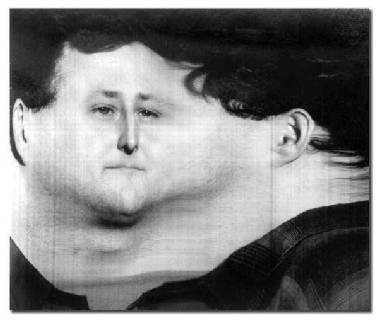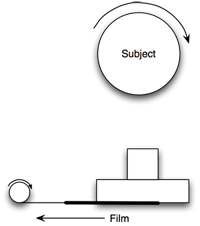Peripheral portraits
An unraveled view
Paul Krzyzanowski
January 12, 2024
This is a peripheral portrait of me taken by Andrew Davidhazy, a now-retired professor of Imaging and Photographic Technology at RIT.

A peripheral photograph attempts to capture a 360° periphery of the subject. Conceptually, this requires the camera to traverse a path around the subject. This is similar to strip photography that is used for aerial surveillance.
In aerial strip photography, a camera aims downward from the fusealge of an airplane. The film in the camera is in constant motion, moving at the same rate as the moving image projected on the film. This movement is synchronized with the airplane’s veloicty. An adjustable-width slit at the focal plane provides control of exposure.
An arial surveillance strip photograph is a special case of a peripheral photograph where
the subject is flat and the camera moves parallel to the periphery. In a roughly
cylindrical object, such as a human face, the camera would have to traverse a circular path.
Equipment for doing this has been designed for applications such as computer
tomography and panoramic radiographs in dentistry.
Low-orbit (approximately 450 km) satellite imaging also uses this technique, employing what is called a push broom sensor. The satellite camera has no shutter and is outfitted with an 8.8 meter (30 ft.) f/14.7 lens. The sensor is 13 inches wide and contains 27,552 pixels, imaging an area 16.8 km wide. Each pixel represents a width of 0.61 meters. See the Popular Photography article, Google Earth — How They Do It or the QuickBird Imagery Products FAQ for more details, and Comparative Analysis of Pixel-Level Fusion Algorithms and a New High-Resolution Dataset for SAR and Optical Image Fusion for even more details.

The portrait here is done via another method: instead of rotating the camera, we rotate the subject. The subject (I) is placed on a turntable and rotated in synchronization with a strip of film that is moving past a slit at the focal plane of a camera. Because of subject movement and irregularities in synchronization, obvious distortions are present. The system used is a low-budget solution: a Polaroid camera has been stripped of its shutter and a slit was placed on the focal plane. A sheet of Polaroid film is pulled out slowly through the slit and out of the camera at the same rate that a turntable is rotating (on which the subject is standing).
For more information, check out Professor Davidhazy’s article on his improvised scanning digital camera.